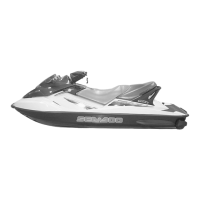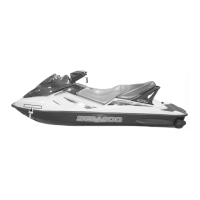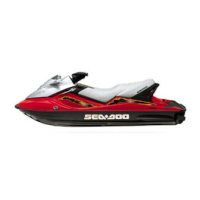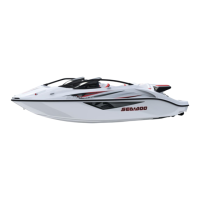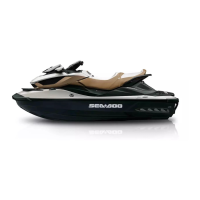Section04ENGINEMANAGEMENT(15034-TEC)
Subsection 01 (OVERVIEW)
NOTE: The memory of the ECM is programmed
to recognize the digital code of the safety lan-
yard cap. This is achieved with the VCK (Vehicle
Communication Kit) (P/N 529 035 981). Refer to
B.U.D.S. help system to program a safety lanyard.
The ECM also offers a special safety lanyard —
the Sea-Doo
®
Learning Key™—which can be pro-
grammed so that the vehicle can be run only at a
limited speed — approximately 55 km/h (35 MPH).
Such feature is ideal for first time riders or renters.
WARNING
When programming a Sea-Doo
®
Learning
Key™, use only a lanyard that is identified for
that purpose. Otherwise, a customer could
use a vehicle with a greater speed than he
was expecting.
When connecting a safety lanyard cap on the post,
the DESS is activated and will emit audible signals:
– 2 short beeps indicate a working safety lanyard.
Engine starting can take place.
– 1 long beep indicates a wrong safety lanyard
is being used or that something is defective.
Engine starting is not allowed.
The ECM features a self-diagnostic mode. Refer
to DIAGNOSTIC PROCEDURES section for more
information.
When ordering a new ECM from the regular parts
channel, the DESS circuitry will be activated.
Safety Lanyard Reminder
If engine is not started within 5 seconds after in-
stalling the safety lanyard on its post, 4 very short
beeps every 3 second interval will sound for ap-
proximately 4 hours to remind you to start the en-
gine or to remove safety lanyard. Afterwards, the
beeps will stop. The same will occur when safety
lanyard is left on its post 5 seconds after engine is
stopped.
Always ensure safety lanyard is not left on its post
after engine is stopped.
IMPORTANT: Leaving the safety lanyard on its
post when engine is not running will slowly dis-
charge the battery.
Engine Modes of Operation
The ECM controls different operation modes of
the engine to allow proper operation for all possi-
ble conditions: Cranking, start-up, idle, warm up,
part load, full load, Sea-Doo
®
Learning Key™ (lim-
ited vehicle speed), engine speed limiter, flooded
engine and limp home.
Engine Starting
If the ECM recognizes a valid safety lanyard, it
allows engine to start when the start/stop button
is pressed.
If start/stop button is held after engine has started,
the ECM automatically stops the starter when the
engine speed reaches 1600 RPM.
If start button is activated while the throttle lever
is depressed more than 65%, the engine will not
beallowedtostart.
Engine RPM Limiter
The ECM will limit the maximum engine speed.
Drowned Mode
If engine is fuel-flooded and does not start, this
special mode can be activated to prevent fuel in-
jection and ignition while cranking. Proceed as fol-
lows to activate it.
With safety lanyard on its post while engine is
stopped, press and HOLD throttle lever.
Press the start/stop button. The mode is now on.
Releasing throttle lever will bring back to its nor-
mal mode.
If engine does not start, it may be necessary to re-
move spark plugs and crank engine with rags over
spark plug holes. Refer to COMPONENT INSPEC-
TION AND ADJUSTMENT subsection.
WARNING
When disconnecting coil from spark plug, al-
ways disconnect coil from main harness first.
Never check for engine ignition spark from
an open coil and/or spark plug in the engine
compartment as spark may cause fuel vapor
to ignite.
If engine is water-flooded, refer to WATER
FLOODED ENGINE in MAINTENANCE section.
76 smr2005-011
